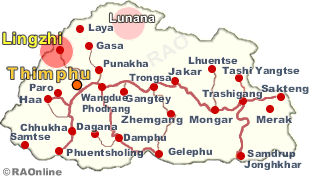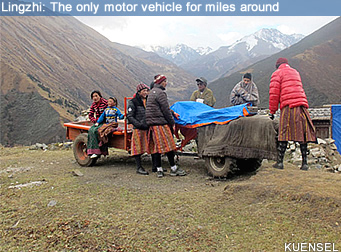 |
Bhutan's Development |
 |
Bhutan Information |
|
|
 |
| Electric Power in Lingzhi |
The arrival of a power tiller in the remote dzongkhag created quite a sensation
 |
|
The power tiller has saved time and labour for the contractor
It might take a while before Lingzhi, one of the remotest gewogs in the country, is connected with road, but those up there aren't going to wait for it.
In fact, they already have one motor vehicle up and running in the gewog, a power tiller.How is that possible?
|
|
It took 11 horses and six men six days and about Nu 60,000 for the power tiller to reach there.
But the power tiller hardly made it in one piece.It was first dismantled into numerous pieces, and the men and animals, after spending nights in open air, carried it up the mountains and down the valleys.That was in April.
Upon reaching Lingzhi, it took another two days for a local mechanic to put it back together.He was paid Nu 500 a day.
 |
|
What followed was not less than a festive moment.People of Lingzhi welcomed the machine with great enthusiasm.While the elders offered khadar, children gaped at it with admiration.
However, after that, the power tiller stood idle.There was no road to ply or work to do.
But more than a month earlier, the owner, Dorji Drakpa from Gangyul chiwog, who bought the machine at Nu 0.28M from Paro, deployed it to carry sands and stones for construction of a staff quarter in the gewog. |
|
They dug up a track for the power tiller, connecting the spot behind Lingzhi dzong, from where stones were fetched, to the construction site.
"It took us several days," said the owner's son Dawa Dhendup, who was given the privilege to drive the power tiller.
But the privilege did not come easy.It took him about five days to acquire the skill to drive it.A carpenter, who had come from Punakha, gave him the lesson.
Today, Dawa Dhendup does a few trips in a day.When they run out of fuel, they bring about 40 litres of diesel on about two to three horses from Paro.
His father Dorji Drakpa said it did wonders in saving time, manpower and money to carry out the work, which otherwise would require a number of men and horses.
However, it was not all smooth or an easy ride.The power tiller broke down five times, required spare parts to be brought from Paro, and the owner spent another Nu 40,000.
The same mechanic was engaged.
"He's not a professional one, but knows a lot about vehicles," Dawa Dhendup said.
Meanwhile, the construction is expected to be complete by June next year.Even if it is not put to use after that, it would remain a prized possession of the gewog.
| Contributed
by Sonam Choden,KUENSEL, Bhutan's National Newspape 2013 |
 |
top
| more information on Bhutan |
 |
|




